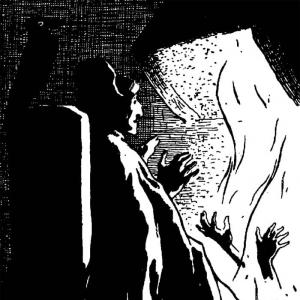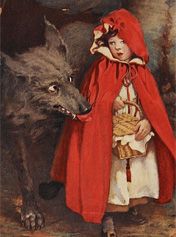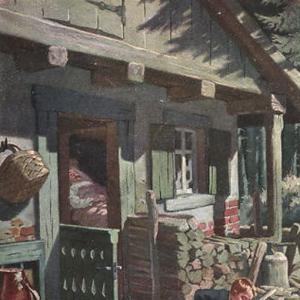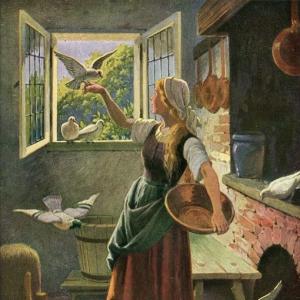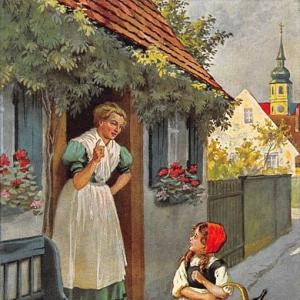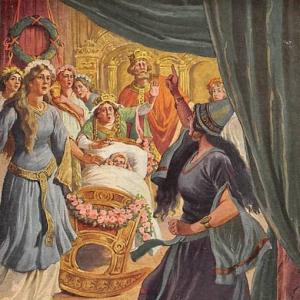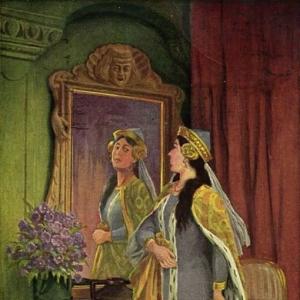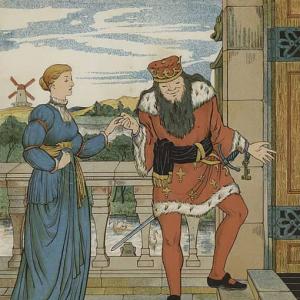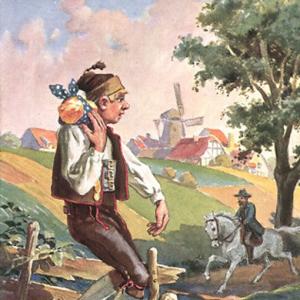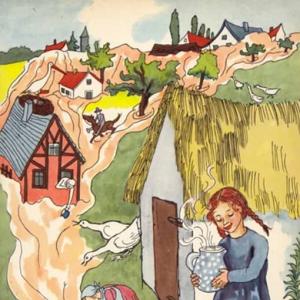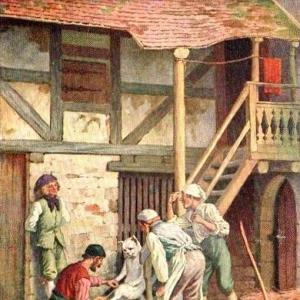Reading time: 13 min
Once upon a time there was a poor woodcutter who worked from morning until late at night. When he had finally saved up some money he said to his boy, „You are my only child. I want to spend the money that I have earned by the sweat of my brow on your education. Learn an honest trade so you can support me in my old age when my limbs have grown stiff and I have to sit at home.“ Then the boy went to a university and studied diligently. His teachers praised him, and he remained there for some time. After he had worked through a few classes, but was still not perfect in everything, the little pittance that the father had saved was all spent, and the boy had to return home to him. „Oh,“ said the father sadly, „I cannot give you anything more, and in these hard times I cannot earn a heller more than what we need for our daily bread.“ – „Father, dear,“ answered the son, „don’t worry about it. If it is God’s will everything will turn out well for me. I will do all right.“ When the father said he was going into the woods and earn some money by cutting cordwood, the son said, „I will go with you and help you.“ – „No, my son,“ said the father, „you will find it too difficult. You are not used to hard work, and will not be able to do it. Furthermore, I have only one ax and no money left to buy another one with.“ – „Just go to the neighbor,“ answered the son. „He will lend you his ax until I have earned enough to buy one for myself.“
So the father borrowed an ax from the neighbor, and the next morning at daybreak they went out into the woods together. The son helped his father and was quite cheerful and full of energy. When the sun was directly above them, the father said, „Let us rest now and eat our noon meal. Then all will go twice as well.“ The son picked up his bread and said, „Just you rest, father. I am not tired. I will walk about a little in the woods and look for birds‘ nests.“ – „Oh, you fool,“ said the father, „why do you want to run about? Afterwards you will be tired and no longer able to lift an arm. Stay here, and sit down beside me.“
But the son went into the woods, ate his bread, was very cheerful, and looked into the green branches to see if he could find a bird’s nest. He walked to and fro until at last he came to an enormous oak that was certainly many hundred years old, and that five men would not have been able to span. He stood there looking at it, and thought, „Many a bird must have built its nest in that tree.“ Then suddenly he thought that he heard a voice. Listening, he became aware of someone calling out with a muffled voice, „Let me out. Let me out.“ He looked around but could not see anything. Then he thought that the voice was coming out of the ground, so he shouted, „Where are you?“ The voice answered, „I am stuck down here among the oak roots. Let me out. Let me out.“ The student began to scrape about beneath the tree, searching among the roots, until at last he found a glass bottle in a little opening. Lifting it up, he held it against the light, and then saw something shaped like a frog jumping up and down inside. „Let me out. Let me out,“ it cried again, and the student, thinking no evil, pulled the cork from the bottle. Immediately a spirit ascended from it and began to grow. It grew so fast that within a few moments a horrible fellow, half as big as the tree, was standing there before the student. „Do you know,“ he cried in an terrifying voice, „what your reward is for having let me out?“ – „No,“ replied the student fearlessly. „How should I know that?“
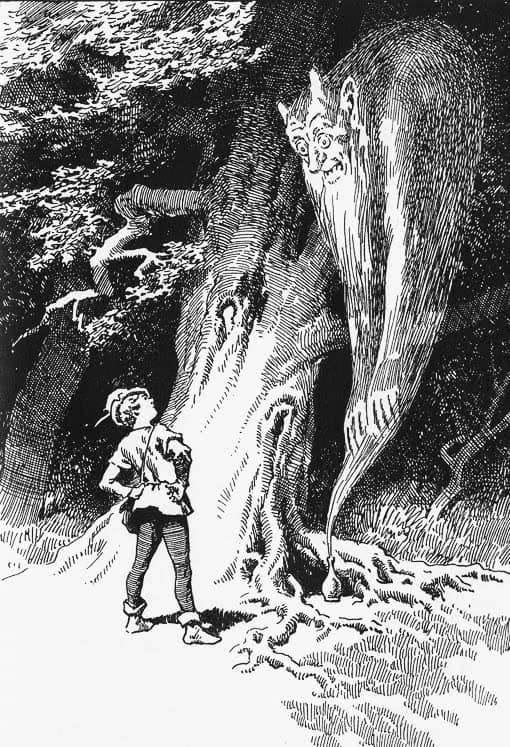
„Then I will tell you,“ shouted the spirit. „I must break your neck for it.“ – „You should have said so sooner,“ answered the student, „for then I would have left you shut up inside. However, my head is going to stay where it is until more people have been consulted.“ – „More people here, more people there,“ shouted the spirit. „You shall have the reward you have earned. Do you think that I was shut up there for such a long time as a favor? No, it was a punishment. I am the mighty Mercurius. I must break the neck of whomsoever releases me.“ – „Calm down,“ answered the student. „Not so fast. First I must know that you really were shut up in that little bottle, and that you are the right spirit. If you can indeed get inside again, then I will believe it, and you may do with me whatsoever you want.“ The spirit said arrogantly, „that is an easy trick,“ pulling himself in and making himself as thin and short as he had been before. He then crept back into the opening and through the neck of the bottle. He was scarcely inside when the student pushed the cork back into the bottle, and threw it back where it had been among the oak roots. And thus the spirit was deceived.
The student was about to return to his father, but the spirit cried out pitifully, „Oh, do let me out. Oh, do let me out.“ – „No,“ answered the student, „not a second time. I will not release a person who once tried to kill me, now that I have captured him again.“ – „If you will set me free,“ cried the spirit, „I will give you so much that you will have enough for all the days of your life.“ – „No,“ answered the student, „you would cheat me like you tried to the first time.“ – „You are giving away your own good fortune,“ said the spirit. „I will not harm you, but instead will reward you richly.“ The student thought, „I will venture it. Perhaps he will keep his word, and in any event he will not get the better of me.“ So he pulled out the cork, and the spirit rose up from the bottle as before, and extended himself, becoming as large as a giant. „Now you shall have your reward,“ he said, handing the student a little rag that looked just like a small bandage. He said, „If you rub a wound with the one end, it will heal, and if you rub steel or iron with the other end, it will turn into silver.“ – „I have to try that,“ said the student. He went to a tree, scratched the bark with his ax, then rubbed it with the one end of the bandage. It immediately closed together and was healed. „Now it is all right,“ he said to the spirit, „and we can part.“ The spirit thanked him for having freed him, and the student thanked the spirit for the present, and returned to his father.
„Where have you been running about?“ said the father. „Why have you forgotten your work? I said that you wouldn’t get anything done.“ – „Don’t be concerned, father. I will make it up.“ – „Make it up indeed,“ said the father angrily. „Don’t bother.“ – „Just watch, father. I will soon cut down that tree there and make it crash.“ Then he took his bandage, rubbed the ax with it, and struck a mighty blow, but because the iron had turned into silver, the cutting edge bent back on itself. „Hey, father, just look what a bad ax you’ve given me. It is all bent out of shape.“ The father was shocked and said, „Oh, what have you done! Now I’ll have to pay for the ax, and I don’t know what with. That is all the good I have from your work.“ – „Don’t get angry,“ said the son, „I will pay for the ax.“ – „Oh, you blockhead,“ cried the father, „How will you pay for it? You have nothing but what I give you. You have students‘ tricks stuck in your head, but you don’t know anything about chopping wood.“
After a little while the student said, „Father, I can’t work any longer after all. Let’s quit for the day.“ – „Now then,“ he answered, „do you think I can stand around with my hands in my pockets like you? I have to go on working, but you may head for home.“ – „Father, I am here in these woods for the first time. I don’t know my way alone. Please go with me.“ His anger had now subsided, so the father at last let himself be talked into going home with him. There he said to the son, „Go and sell the damaged ax and see what you can get for it. I will have to earn the difference, in order to pay the neighbor.“ The son picked up the ax and took it into town to a goldsmith, who tested it, weighed it, and then said, „It is worth four hundred talers. I do not have that much cash with me.“ The student said, „Give me what you have. I will lend you the rest.“ The goldsmith gave him three hundred talers and owed him one hundred. Then the student went home and said, „Father, I have some money. Go and ask the neighbor what he wants for the ax.“ – „I already know,“ answered the old man. „One taler, six groschens.“ – „Then give him two talers, twelve groschens. That is double its worth and is plenty. See, I have more than enough money.“ Then he gave the father a hundred talers, saying, „You shall never need anything. Live just like you want to.“ – „My goodness,“ said the old man. „Where did you get all that money?“ Then the son told him everything that had happened, and how by trusting in his luck he had made such a catch. With the money that was left he went back to the university and continued his studies, and because he could heal all wounds with his bandage he became the most famous doctor in the whole world.
 Learn languages. Double-tap on a word.Learn languages in context with Childstories.org and Deepl.com.
Learn languages. Double-tap on a word.Learn languages in context with Childstories.org and Deepl.com.Backgrounds
Interpretations
Adaptions
Summary
Linguistics
„The Spirit in the Bottle“ is a German fairy tale collected by the Brothers Grimm, Jacob and Wilhelm, in their famous book „Grimms‘ Fairy Tales“ (originally titled „Kinder- und Hausmärchen“ or „Children’s and Household Tales“). The first edition of this book was published in 1812, and it has since been translated into numerous languages and become an essential part of the Western literary canon.
The Brothers Grimm were German philologists, lexicographers, and folklorists who lived during the late 18th and early 19th centuries. They sought to preserve and document Germanic folklore, which was rapidly disappearing due to industrialization and urbanization. To collect these stories, the brothers interviewed people from various social backgrounds, including peasants, middle-class families, and the aristocracy. Their fairy tale collection is considered one of the most significant works of German literature and has had a profound impact on children’s literature worldwide.
The fairy tales collected by the Brothers Grimm often contain elements of magic, adventure, and moral lessons. „The Spirit in the Bottle“ is no exception, as it revolves around a magical spirit and a clever protagonist who uses his wit to overcome challenges and improve his life. The story reflects themes common to many fairy tales, such as the importance of education, resourcefulness, trusting in one’s abilities, and the transformative power of magic.
„The Spirit in the Bottle“ offers several interpretations that can be drawn from its narrative:
The value of education: The woodcutter recognizes the importance of education in improving his son’s future prospects. Despite their poverty, he invests in his son’s education, which eventually leads to the son becoming a renowned doctor.
Cleverness and resourcefulness: The student demonstrates his wit and resourcefulness by outsmarting the spirit twice. First, he tricks the spirit back into the bottle, and later, he negotiates a beneficial deal with the spirit, gaining a magical rag that ultimately improves their lives.
Trust in one’s abilities and fortune: The son trusts his abilities and instincts throughout the story, which helps him make the most of the opportunities that arise. His trust in his luck and intelligence allows him to succeed, even when faced with adversity.
The power of good intentions: The student’s good intentions in helping his father and seeking an honest way to support him in his old age are rewarded when he discovers the magical spirit. This can be interpreted as a message that good intentions and hard work can lead to positive outcomes.
The transformative power of magic: The magical rag symbolizes the potential for transformation and growth, both in terms of material wealth and personal development. The son uses the rag to heal wounds and convert steel into silver, which helps him become a successful doctor and provide for his family.
Overall, „The Spirit in the Bottle“ offers a narrative that emphasizes the importance of education, resourcefulness, trust in oneself, good intentions, and the power of transformation in overcoming challenges and improving one’s life.
„The Spirit in the Bottle“ is a popular fairy tale from Brothers Grimm, and it has been adapted in various forms over the years. Here are some notable adaptations:
Operas: The story has been adapted into several operas, including „Der fliegende Holländer“ (The Flying Dutchman) by Richard Wagner and „The Bottle Imp“ by Eugene Goossens.
Films: The story has also been adapted into several films, including the 1950 film „The Baron of Arizona,“ which was loosely based on the tale.
TV shows: The story has been adapted into several TV shows, including the episode „The Spirit in the Bottle“ of the popular 1980s show „Faerie Tale Theater.“
Children’s books: The story has been adapted into several children’s books, including „The Spirit in the Bottle“ by Arnold Lobel and „The Spirit in the Bottle: A Tale from the Brothers Grimm“ by Margaret Early.
Plays: The story has been adapted into several plays, including „The Spirit in the Bottle“ by Nathan Hartswick.
Graphic novels: The story has been adapted into a graphic novel by Scott Roberts, titled „The Bottle Imp.“
Video games: The story has also been adapted into a video game called „The Spirit in the Bottle,“ which was released in 2019.
Overall, „The Spirit in the Bottle“ has been adapted in various forms, highlighting its enduring popularity and relevance.
„The Spirit in the Bottle“ is a fairy tale by the Brothers Grimm about a poor woodcutter and his son who stumble upon a magical spirit trapped inside a bottle. The woodcutter sends his son to university, but when their money runs out, the son returns home to help his father. One day, while resting in the woods, the son discovers the bottle with the spirit inside.
After releasing the spirit, it grows into a giant and threatens to kill the boy. The clever student tricks the spirit back into the bottle, only to be persuaded to release it again in exchange for a magical rag that can heal wounds and turn steel into silver. The spirit keeps its word, and the student uses the rag to transform the damaged ax into silver.
The son takes the silver ax to a goldsmith, who values it at four hundred talers. The goldsmith only has three hundred talers, so the son lends him the difference. Returning home, the son gives his father the money and pays off the neighbor’s ax, doubling its value. The father is astonished by their newfound wealth.
With the remaining money, the son returns to university and becomes a famous doctor, thanks to the magical rag that can heal any wound. The story emphasizes the importance of trusting one’s luck and cleverness to overcome challenges and improve one’s circumstances.
The Brothers Grimm’s fairy tale „The Spirit in the Bottle“ offers a rich text for linguistic and thematic analysis.
Here is a brief analysis that considers several key elements:
Narrative Structure and Themes
Classic Fairy Tale Elements:
Opening and Closing: The story begins with „Once upon a time,“ a traditional fairy tale opening that situates the narrative within an undefined, timeless past. It closes with the protagonist achieving success, a hallmark of fairy tales.
Moral Lessons: The story reinforces the virtue of cleverness and resourcefulness. The student’s quick thinking allows him to outsmart the spirit, suggesting the value of intelligence over brute strength.
Character Archetypes
The Poor but Wise Father: Represents the older generation, valuing education and wisdom as means of ensuring a better future.
The Protagonist/Student: Embodies youthful curiosity, intelligence, and adaptability—qualities that ultimately lead to prosperity and fulfillment.
The Trickster Spirit: A common fairy tale figure that represents chaos and the unforeseen consequences of curiosity, akin to the Pandora’s box myth.
Conflict and Resolution: The main conflict involves the release of the spirit and the threat it poses. The resolution through the trickery of the student emphasizes wit over might.
Dialogue: Direct speech is used extensively, which is a typical feature of fairy tales that allows for clear character interaction and development.
Symbolism
The Bottle: Represents confinement and unleashing of potentially destructive forces, echoes of curiosity leading to unintended consequences.
The Bandage/Rag: Symbolizes dual qualities—healing and wealth. It represents the dual nature of gifts or skills that can provide for both spiritual (healing) and material (turning metal into silver) needs.
Repetitive Structures: The use of repetition, such as the spirit’s repeated plea for release („Let me out“), emphasizes the persistence of challenges and the need for careful decision-making.
Socio-Economic Context
– The story reflects economic struggles and aspirations for social mobility through education, a common theme in the Grimm tales. The father’s desire for his son’s education signifies an investment in knowledge as a route out of poverty.
Folklore and Cultural Context
– The tale may have served as a cautionary reminder of the dangers of unbridled curiosity and the necessity of wisdom to navigate life’s challenges. It illustrates the interplay between magic and reality, a prevalent motif in folklore meant to teach and entertain.
Overall, „The Spirit in the Bottle“ illustrates the importance of intelligence and wisdom in overcoming life’s obstacles while reflecting societal values and beliefs from the time of the Brothers Grimm.
Information for scientific analysis
Fairy tale statistics | Value |
|---|---|
| Number | KHM 99 |
| Aarne-Thompson-Uther-Index | ATU Typ 331 |
| Translations | DE, EN, DA, ES, FR, PT, HU, IT, JA, NL, PL, RO, RU, TR, VI, ZH |
| Readability Index by Björnsson | 23.1 |
| Flesch-Reading-Ease Index | 87.9 |
| Flesch–Kincaid Grade-Level | 4.3 |
| Gunning Fog Index | 6.5 |
| Coleman–Liau Index | 7.2 |
| SMOG Index | 7 |
| Automated Readability Index | 3.5 |
| Character Count | 8.953 |
| Letter Count | 6.731 |
| Sentence Count | 131 |
| Word Count | 1.724 |
| Average Words per Sentence | 13,16 |
| Words with more than 6 letters | 172 |
| Percentage of long words | 10% |
| Number of Syllables | 2.152 |
| Average Syllables per Word | 1,25 |
| Words with three Syllables | 56 |
| Percentage Words with three Syllables | 3.2% |

 Facebook
Facebook  Whatsapp
Whatsapp  Messenger
Messenger  Telegram
Telegram Reddit
Reddit
